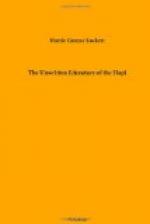From the accounts of many observers that of Hough[25] has been chosen: “On the first day the sand altar is made and at night songs are begun. Within the kiva the interminable rites go on, and daily the cycle of songs accompanied with flutes is rehearsed. A messenger clad in an embroidered kilt and anointed with honey, runs, with flowing hair, to deposit prayer-sticks at the shrines, encircling the fields in his runs and coming nearer the pueblo on each circuit. During the seventh and eighth days a visit is made to three important springs where ceremonies are held, and on the return of the priests they are received by an assemblage of the Bear and Snake Societies, the chiefs of which challenge them and tell them that if they are good people, as they claim, they can bring rain.
[Footnote 25: Hough, Walter, Op. cit., pp. 156-158.]
“After an interesting interchange of ceremonies, the Flute priests return to their kiva to prepare for the public dance on the morrow. When at 3:00 a.m. the belt of Orion is at a certain place in the heavens, the priests file into the plaza, where a cottonwood bower has been erected over the shrine called the entrance to the underworld. Here the priests sing, accompanied with flutes, the shrine is ceremonially opened and prayer-sticks placed within, and they return to the kiva. At some of the pueblos there is a race up the mesa at dawn on the ninth day, as in other ceremonies.
“On the evening of the ninth day the Flute procession forms and winds down the trail to the spring in order: A leader, the Snake maiden, two Snake youths, the priests, and in the rear a costumed warrior with bow and whizzer. At the spring they sit on the south side of the pool, and as one of the priests plays a flute the others sing, while one of their number wades into the spring, dives under water, and plants a prayer-stick in the muddy bottom. Then taking a flute he again wades into the spring and sounds it in the water to the four cardinal points. Meanwhile sunflowers and cornstalks have been brought to the spring by messengers. Each priest places the sunflowers on his head and each takes two cornstalks in his hands and the procession, two abreast, forms to ascend the mesa. A priest draws a line on the trail with white corn meal and across it three cloud symbols. The Flute children throw the offerings they hold in their hands upon the symbols, followed by the priests who sing to the sound of the flutes.
[Illustration: Figure 5.—Flute Ceremony at Michongnovi.
—Courtesy Arizona State Museum.]
“The children pick the offerings from the ground with sticks held in their hands, and the same performance is repeated till they stand again in the plaza on the mesa before the cottonwood bower, where they sing melodious songs then disperse.”
The foregoing description of Hough’s is an account of the Walpi ceremony, where we find only one Flute fraternity. Each of the other villages has two fraternities, the Blue Flute and the Drab Flute. The Flute Ceremony at Mishongnovi is perhaps the most impressive example of this pageant as given by the double fraternity. Dr. Byron Cummings reports this Mishongnovi ceremony as having several interesting variations from the Walpi report given above. (See Figure 5.)




